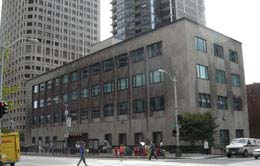On January 2, 1951, the new building housing the Seattle branch of the Federal Reserve Bank of San Francisco opens at 2nd Avenue and Madison Street in downtown Seattle. Architect William Bain Sr. of the firm NBBJ (Naramore, Bain, Brady, Johanson) designed the building in the Moderne style. Its austerity and visual weight, as well as its relatively short stature, stand out among the many skyscrapers in the surrounding financial district. The bank will operate out of the building for more than 50 years. In 2008 the branch will move to a larger building in Renton to meet its need for increased space and security.
The branch had operated in rented spaces since its opening in 1917. In 1949 the directors of the Federal Reserve Bank of San Francisco authorized the building of a branch in Seattle. Architect William Bain Sr. (1896-1985) designed the building in the Moderne style, with a minimally adorned exterior and a low, horizontal form. Moderne style dated to the pre-war era and was related to Art Deco, except that it emphasized horizontal lines and simpler exterior details. According to the Landmark Nomination prepared by BOLA Architecture + Planning, several federal buildings designed in this style featured "classically inspired facades, a strong plinth, [and] horizontal massing," giving a sense of security and permanence, which in the case of the bank building was increased by the thick, blast-resistant windows framed with granite (Landmark Nomination, 14). The exterior of the bank building was smooth, interrupted only by the window bays. In its conservatism and solidity, the Federal Reserve Bank exuded a sense of security and permanence.
On the eve of the opening, all of the currency from the old location at 1110 2nd Avenue had to be transferred to the two-story vault in the new building. Movers transferred a total of $400 million in bills and securities and $400,000 in coins overnight on December 29 and 30, 1951.
An open house held on January 12, 1951, for 250 invited guests included guided tours of the new facilities. The day culminated in a dinner for 300 at The Olympic Hotel. C. E. Earhart, president of the Federal Reserve Bank of San Francisco, and Edward L. Norton, of the Board of Governors of the Federal Reserve, and several local businessmen spoke at the dinner.
A second open house on January 13, 1951, welcomed the public to the new building. An article in the 12-L News reported that about 900 visitors came to tour the building and "As always, of course, the first question asked by most guests was either, 'Where is the vault?' or 'Where is the money?'" ("Seattle Branch Holds Open House," 2). Female employees stationed at the entrance greeted visitors while guides and signage explained the different areas and functions of the bank. Visitors could walk through the two-story vault with 30-inch concrete walls and tour the cafeteria on the sixth floor.
At first the bank did not need all of the 110,000 square feet in the building and the Federal Bureau of Investigation occupied a portion of the offices. After 50 years, however, the space no longer served the bank's needs and a new site in Renton was chosen for a larger building that could be more easily secured. The Seattle Federal Reserve building closed its doors in February 2008; it remained unoccupied as of fall 2008.

